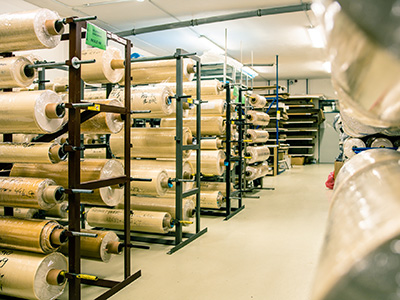A membrane is a highly performing multifunctional barrier that divides two media and allows or prevents the transport of different substances, thus in a highly selective way. It is a crucial component of all membrane processes.
The boom of membrane processes requires constant innovations in membrane materials. Our applied research is devoted to the development and improvement of:
1. RALEX® Ion-exchange membranes in the form of:
a. flat sheet membranes used for electrodialysis, electrodeionization, membrane electrolysis,
b. tubular membranes for electrophoresis (see mega.cz/membranes/),
c. hollow fibre membranes for diffusion dialysis.
2. RALEX® bipolar membranes in the form of flat sheets used for electrodialysis with bipolar membranes (EDMB).
3. Membranes for gas separation in the form of hollow fibres.
OUR FACILITIES AND DEVICES FOR MEMBRANE PRODUCTION
We have complete equipment for membrane production on the R&D level, i.e.:
• Vibration laboratory and pilot mill for ion-exchange resins and additive grinding.
• Equipment for the semi-operational research of new ion-selective membranes and highly filled polymeric composites.
• The co-extrusion lamination lines for the production of flat-sheet membranes and different types of plastic films.
• Extrusion line for production of tubular ion-exchange membranes, i.e. for cataphoretic coating
• The line for production of hollow fibre membranes.
For more information, see Membrane Innovation Centre.
WE OFFER
• Research and implementation of new materials of heterogeneous ion-exchange membranes.
• Optimization and development of new technologies to produce heterogeneous membranes.
- Pre-treatment of ion-exchangers.
- Preparation of membrane composite.
- Production of laminated or non-laminated membranes.
- Swelling and formatting of membranes.
• Development of new types of heterogeneous membranes for specific purposes.
• Development of new laboratory methods for characterization of membrane parameters.
• Characterization of membrane quality in MemBrain laboratories.
• Cooperation with research institutions and commercial partners.

ION-EXCHANGE MEMBRANES
The material composition of membranes forms its characteristic structure. We characterize two types of membranes according to their structure: homogeneous and heterogeneous. The membranes developed and manufactured by MEGA/MemBrain are heterogeneous RALEX® membranes.
A heterogeneous membrane is a highly filled polymeric composite consisting of finely ground polymeric particles with ion-exchange functional groups. These are embedded in an inert polymeric matrix with the reinforcing textile that improves the membrane’s mechanical properties.
According to the functional group, we characterize:
(i) cation-exchange membranes (CM) transferring cations and
(ii) anion-exchange membranes (AM) transferring anions,
while both types of membranes block the hydrodynamic flow of the solvent.
The selectivity and blocking of the flow are used in individual processes. These mainly include separation, demineralization and concentration processes in electrodialysis, electrophoresis, electrolysis or electrodeionization. The selective permeability for certain substances causes the transmission of some substances to be slowed down considerably or even blocked, while the preferred components permeate very easily.
The main advantages of heterogeneous membranes are:
• Excellent mechanical properties
• Chemical stability (CIP pH 1-14)
• High perm-selectivity
• Better transport of multivalent ions
• High concentrations achievable
• Higher C:D ratio achievable, making ZLD a more suitable process
• High current densities achievable
• Long lifetime
• Lower price thanks to the simple production process
• Possibility to manufacture different shapes due to the thermoplastic substances
MEGA is a producer of two standard types of the RALEX® membranes: CM(H) and AM(H), either with polyester (PES) or polypropylene (PP) fitting fabrics according to the expected pH of the application (CM-PES and AM-PES for pH up to 10, CM-PP and AM-PP for pH above 10). In addition, MEGA has a leading position in the market as a producer of heterogeneous membranes. For the datasheets of manufactured membranes, see Membranes.
Anion-exchange hollow fibre membranes for diffusion dialysis
We developed membranes in the form of hollow fibres to regenerate the combination of nitric acid (HNO3) and hydrofluoric acid (HF) with the following characteristics:
• Heterogeneous (composite) material
• Cheap production
• Excellent chemical resistivity
• Possible to form different types of membrane modules
In the technological laboratory, we are equipped with a production line for hollow fibre membranes. For more information, see Cooperation & Services.
RALEX ® BIPOLAR MEMBRANES
A bipolar membrane is a cation-exchange membrane combined with an anion-exchange membrane through an intermediate layer (the “junction” layer). This membrane arrangement placed in a high-density electric field enhances dissociation (splitting) of water into H+ and OH- ions.
The membrane allows low energy production of H+and OH- ions in electrodialysis systems. However, high water diffusion is also needed.
The main advantages of our bipolar membrane are:
• Good thermal resistance (inside membrane stack under DC 40 °C, for a short time 45 °C)
• Resistance against aggressive chemicals and fouling components, except strong oxidizing agents
• Long-term stability at pH 0-14
• Strong binder
• Easy production
• Lower price
• Possible for industrial use
Applications:
• Production of acids and hydroxides.
• Regeneration of acids and hydroxides to reuse in the previous operation.
• Treatment of salt waste stream (typically for ZLD processes).
• Acidification and alkalinization (Separation of soy proteins, Stabilization of unfiltered apple juice).
MEMBRANES FOR GAS SEPARATION
We are constantly improving our hollow fibre membranes for gas separation. These membranes are part of our laboratory modules.
Currently, we focus on the following issues:
• Innovation of technological equipment of MemBrain for the hollow fibre membrane production with length up to 2 meters,
• Development of advanced membranes for carbon dioxide (CO2) separation from exhaust gases



